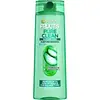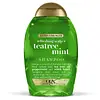What's inside
What's inside
 Key Ingredients
Key Ingredients

 Benefits
Benefits

 Concerns
Concerns

 Ingredients Side-by-side
Ingredients Side-by-side

Water
Skin ConditioningSodium Laureth Sulfate
CleansingCoco-Betaine
CleansingGlycerin
HumectantSodium Chloride
MaskingHexylene Glycol
EmulsifyingPolyquaternium-10
Sodium Benzoate
MaskingParfum
MaskingPEG-60 Hydrogenated Castor Oil
EmulsifyingPyrus Malus Fruit Extract
Skin ConditioningSalicylic Acid
MaskingAloe Barbadensis Leaf Juice
Skin ConditioningLinalool
PerfumingNiacinamide
SmoothingPyridoxine Hcl
Skin ConditioningHexyl Cinnamal
PerfumingCitric Acid
BufferingSaccharum Officinarum Extract
MoisturisingSodium Acetate
BufferingHydroxypropyltrimonium Lemon Protein
HumectantIsopropyl Alcohol
SolventTocopherol
AntioxidantPhenoxyethanol
PreservativeCitrus Grandis
Citrus Limon Peel Extract
EmollientLeuconostoc/Radish Root Ferment Filtrate
AntimicrobialCamellia Sinensis Leaf Extract
AntimicrobialPotassium Sorbate
PreservativeSodium Hydroxide
BufferingWater, Sodium Laureth Sulfate, Coco-Betaine, Glycerin, Sodium Chloride, Hexylene Glycol, Polyquaternium-10, Sodium Benzoate, Parfum, PEG-60 Hydrogenated Castor Oil, Pyrus Malus Fruit Extract, Salicylic Acid, Aloe Barbadensis Leaf Juice, Linalool, Niacinamide, Pyridoxine Hcl, Hexyl Cinnamal, Citric Acid, Saccharum Officinarum Extract, Sodium Acetate, Hydroxypropyltrimonium Lemon Protein, Isopropyl Alcohol, Tocopherol, Phenoxyethanol, Citrus Grandis, Citrus Limon Peel Extract, Leuconostoc/Radish Root Ferment Filtrate, Camellia Sinensis Leaf Extract, Potassium Sorbate, Sodium Hydroxide
Water
Skin ConditioningSodium C14-16 Olefin Sulfonate
CleansingCocamidopropyl Betaine
CleansingMelaleuca Alternifolia Leaf Oil
AntioxidantMentha Piperita Leaf Extract
Skin ConditioningHamamelis Virginiana Leaf Extract
Skin ConditioningMenthol
MaskingMenthyl Lactate
MaskingPolyquaternium-22
Linoleamidopropyl Pg-Dimonium Chloride Phosphate
PEG-7 Amodimethicone
HumectantPolyquaternium-39
Sodium Hydrolyzed Potato Starch Dodecenylsuccinate
Disodium Tetrapropenyl Succinate
PEG-150 Pentaerythrityl Tetrastearate
EmulsifyingPPG-2 Hydroxyethyl Cocamide
EmulsifyingGlycerin
HumectantPropylene Glycol
HumectantSodium Citrate
BufferingHexylene Glycol
EmulsifyingSodium Hydroxide
BufferingCitric Acid
BufferingSodium Benzoate
MaskingParfum
MaskingWater, Sodium C14-16 Olefin Sulfonate, Cocamidopropyl Betaine, Melaleuca Alternifolia Leaf Oil, Mentha Piperita Leaf Extract, Hamamelis Virginiana Leaf Extract, Menthol, Menthyl Lactate, Polyquaternium-22, Linoleamidopropyl Pg-Dimonium Chloride Phosphate, PEG-7 Amodimethicone, Polyquaternium-39, Sodium Hydrolyzed Potato Starch Dodecenylsuccinate, Disodium Tetrapropenyl Succinate, PEG-150 Pentaerythrityl Tetrastearate, PPG-2 Hydroxyethyl Cocamide, Glycerin, Propylene Glycol, Sodium Citrate, Hexylene Glycol, Sodium Hydroxide, Citric Acid, Sodium Benzoate, Parfum
 Reviews
Reviews

Ingredients Explained
These ingredients are found in both products.
Ingredients higher up in an ingredient list are typically present in a larger amount.
Citric Acid is an alpha hydroxy acid (AHA) naturally found in citrus fruits like oranges, lemons, and limes.
Like other AHAs, citric acid can exfoliate skin by breaking down the bonds that hold dead skin cells together. This helps reveal smoother and brighter skin underneath.
However, this exfoliating effect only happens at high concentrations (20%) which can be hard to find in cosmetic products.
Due to this, citric acid is usually included in small amounts as a pH adjuster. This helps keep products slightly more acidic and compatible with skin's natural pH.
In skincare formulas, citric acid can:
While it can provide some skin benefits, research shows lactic acid and glycolic acid are generally more effective and less irritating exfoliants.
Most citric acid used in skincare today is made by fermenting sugars (usually from molasses). This synthetic version is identical to the natural citrus form but easier to stabilize and use in formulations.
Read more about some other popular AHA's here:
Learn more about Citric AcidGlycerin is already naturally found in your skin. It helps moisturize and protect your skin.
A study from 2016 found glycerin to be more effective as a humectant than AHAs and hyaluronic acid.
As a humectant, it helps the skin stay hydrated by pulling moisture to your skin. The low molecular weight of glycerin allows it to pull moisture into the deeper layers of your skin.
Hydrated skin improves your skin barrier; Your skin barrier helps protect against irritants and bacteria.
Glycerin has also been found to have antimicrobial and antiviral properties. Due to these properties, glycerin is often used in wound and burn treatments.
In cosmetics, glycerin is usually derived from plants such as soybean or palm. However, it can also be sourced from animals, such as tallow or animal fat.
This ingredient is organic, colorless, odorless, and non-toxic.
Glycerin is the name for this ingredient in American English. British English uses Glycerol/Glycerine.
Learn more about GlycerinHexylene Glycol is a surfactant. Glycols are a class of alcohols. Hexylene Glycol is a surfactant and emulsifier.
As a surfactant, Hexylene Glycol helps gather dirt and oil on your skin to be washed away.
As an emulsifier, Hexylene Glycol helps keep water and oil together. This prevents them from separating in a product. Hexylene Glycol also thins out the texture of a product by lessening viscosity.
Hexylene Glycol has a small molecular weight.
Learn more about Hexylene GlycolParfum is a catch-all term for an ingredient or more that is used to give a scent to products.
Also called "fragrance", this ingredient can be a blend of hundreds of chemicals or plant oils. This means every product with "fragrance" or "parfum" in the ingredients list is a different mixture.
For instance, Habanolide is a proprietary trade name for a specific aroma chemical. When used as a fragrance ingredient in cosmetics, most aroma chemicals fall under the broad labeling category of “FRAGRANCE” or “PARFUM” according to EU and US regulations.
The term 'parfum' or 'fragrance' is not regulated in many countries. In many cases, it is up to the brand to define this term.
For instance, many brands choose to label themselves as "fragrance-free" because they are not using synthetic fragrances. However, their products may still contain ingredients such as essential oils that are considered a fragrance by INCI standards.
One example is Calendula flower extract. Calendula is an essential oil that still imparts a scent or 'fragrance'.
Depending on the blend, the ingredients in the mixture can cause allergies and sensitivities on the skin. Some ingredients that are known EU allergens include linalool and citronellol.
Parfum can also be used to mask or cover an unpleasant scent.
The bottom line is: not all fragrances/parfum/ingredients are created equally. If you are worried about fragrances, we recommend taking a closer look at an ingredient. And of course, we always recommend speaking with a professional.
Learn more about ParfumSodium Benzoate is a preservative. It's used in both cosmetic and food products to inhibit the growth of mold and bacteria. It is typically produced synthetically.
Both the US FDA and EU Health Committee have approved the use of sodium benzoate. In the US, levels of 0.1% (of the total product) are allowed.
Sodium benzoate works as a preservative by inhibiting the growth of bacteria inside of cells. It prevents the cell from fermenting a type of sugar using an enzyme called phosphofructokinase.
It is the salt of benzoic acid. Foods containing sodium benzoate include soda, salad dressings, condiments, fruit juices, wines, and snack foods.
Studies for using ascorbic acid and sodium benzoate in cosmetics are lacking, especially in skincare routines with multiple steps.
We always recommend speaking with a professional, such as a dermatologist, if you have any concerns.
Learn more about Sodium BenzoateSodium Hydroxide is also known as lye or caustic soda. It is used to adjust the pH of products; many ingredients require a specific pH to be effective.
In small amounts, sodium hydroxide is considered safe to use. However, large amounts may cause chemical burns due to its high alkaline.
Your skin has a natural pH and acid mantle. This acid mantle helps prevent harmful bacteria from breaking through. The acid mantle also helps keep your skin hydrated.
"Alkaline" refers to a high pH level. A low pH level would be considered acidic.
Learn more about Sodium HydroxideWater. It's the most common cosmetic ingredient of all. You'll usually see it at the top of ingredient lists, meaning that it makes up the largest part of the product.
So why is it so popular? Water most often acts as a solvent - this means that it helps dissolve other ingredients into the formulation.
You'll also recognize water as that liquid we all need to stay alive. If you see this, drink a glass of water. Stay hydrated!
Learn more about Water